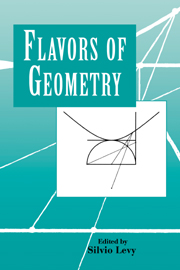Hyperbolic Geometry
Published online by Cambridge University Press: 27 June 2025
Summary
1. Introduction
Hyperbolic geometry was created in the first half of the nineteenth century in the midst of attempts to understand Euclid's axiomatic basis for geometry. It is one type of non-Euclidean geometry, that is, a geometry that discards one of Euclid's axioms. Einstein and Minkowski found in non-Euclidean geometry a geometric basis for the understanding of physical time and space. In the early part of the twentieth century every serious student of mathematics and physics studied non-Euclidean geometry. This has not been true of the mathematicians and physicists of our generation. Nevertheless with the passage of time it has become more and more apparent that the negatively curved geometries, of which hyperbolic non-Euclidean geometry is the prototype, are the generic forms of geometry. They have profound applications to the study of complex variables, to the topology of two- and three-dimensional manifolds, to the study of finitely presented infinite groups, to physics, and to other disparate fields of mathematics. A working knowledge of hyperbolic geometry has become a prerequisite for workers in these fields.
These notes are intended as a relatively quick introduction to hyperbolic geometry. They review the wonderful history of non-Euclidean geometry. They give five different analytic models for and several combinatorial approximations to non-Euclidean geometry by means of which the reader can develop an intuition for the behavior of this geometry. They develop a number of the properties of this geometry that are particularly important in topology and group theory. They indicate some of the fundamental problems being approached by means of non-Euclidean geometry in topology and group theory.
Information
- Type
- Chapter
- Information
- Flavors of Geometry , pp. 59 - 116Publisher: Cambridge University PressPrint publication year: 1997
Accessibility standard: Unknown
- 20
- Cited by
